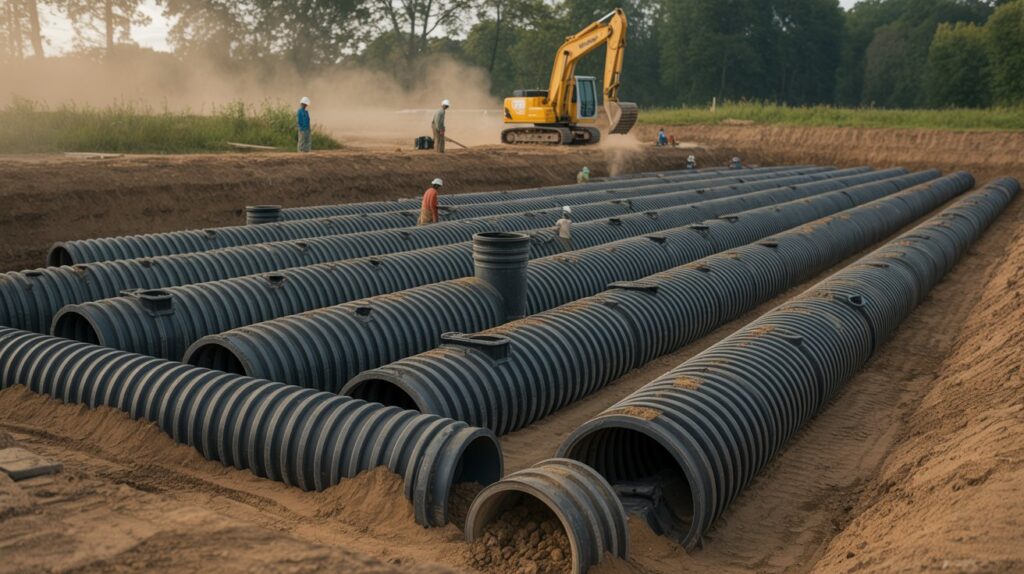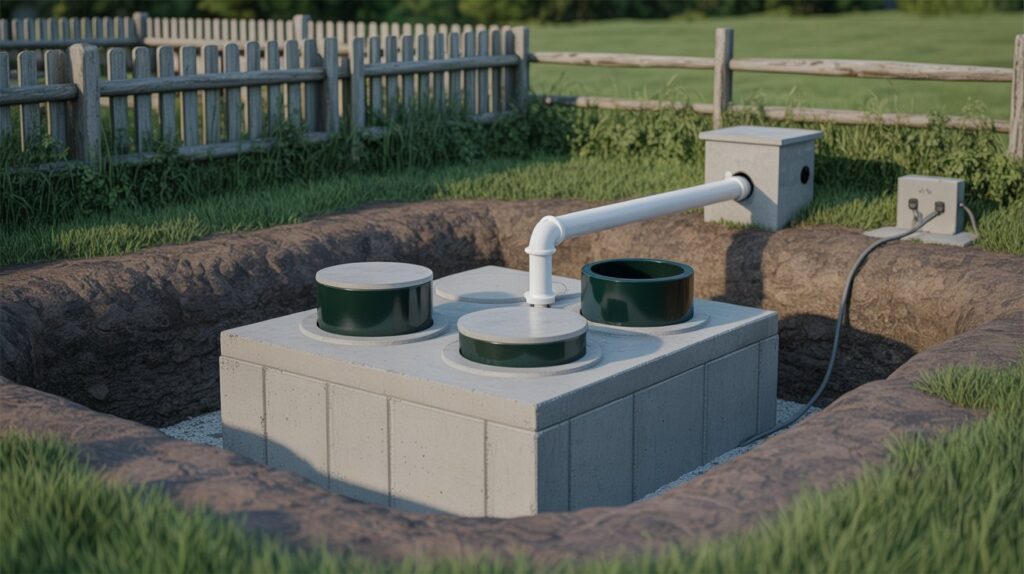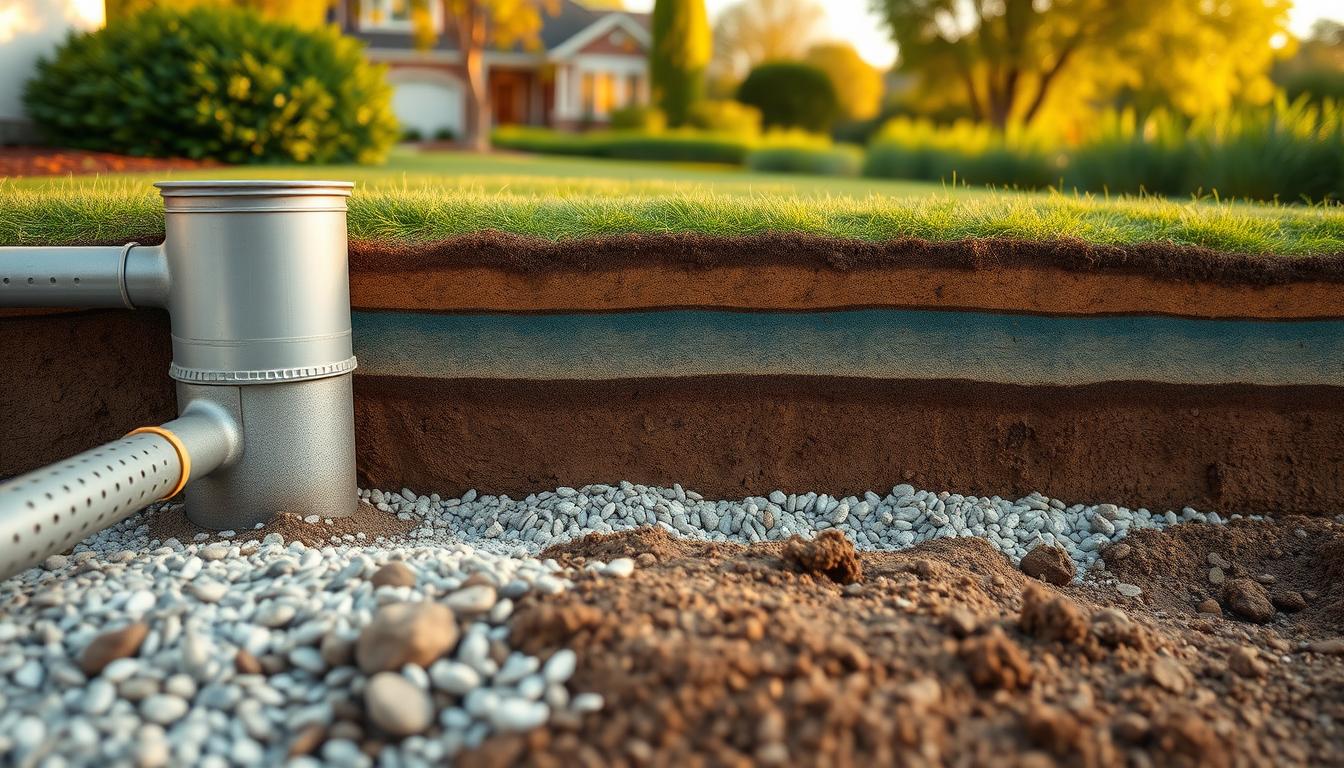Are you aware of the crucial role a drain field plays in your home’s wastewater treatment system? Many homeowners overlook this vital component, yet it is essential for maintaining a healthy environment and preventing costly repairs.
A septic tank drain field, also known as a leach field, is responsible for dispersing treated wastewater into the soil. According to the US EPA, this process is critical for filtering out harmful bacteria and contaminants, ensuring groundwater remains safe.
Understanding the basics of your septic system’s drain field can help you identify potential issues before they become major problems. By grasping the fundamentals, you can take proactive steps to maintain your system and protect your property.
Key Takeaways
- Understanding the role of a drain field is crucial for homeowners with septic systems.
- A septic tank drain field disperses treated wastewater into the soil.
- Proper maintenance of the drain field is essential for preventing costly repairs.
- The US EPA emphasizes the importance of a well-functioning drain field in maintaining groundwater quality.
- Regular inspections can help identify potential issues before they become major problems.
Understanding Septic Tank Drain Field Basics
A septic tank drain field is a vital component of a septic system, playing a key role in wastewater treatment. It’s essential to understand how this system works to appreciate its importance in maintaining a healthy environment and functioning septic system.
What Is a Septic Tank Drain Field?
A septic tank drain field, also known as a leach field, is a network of perforated pipes laid out in trenches, typically filled with gravel or other porous materials. According to the Ontario Building Code, “a conventional septic system consists of a septic tank and a leaching bed.” The leaching bed is designed to filter wastewater before it seeps back into the ground, acting as a natural filter to clean the water.
The drain field is a critical component because it disperses the treated wastewater from the septic tank into the soil. The soil then further treats the wastewater through various biological processes, removing harmful pathogens and nutrients.
How Drain Fields Work in a Septic System
The process of how drain fields work is intricate and involves several key steps:
- Wastewater from the house flows into the septic tank, where solids settle and are broken down.
- The liquid effluent then flows into the drain field through a network of pipes.
- The effluent is dispersed into the gravel or porous material, where it is filtered and treated.
- The treated effluent then percolates through the soil, where it is further purified before reaching groundwater.
Efficient drain field operation is crucial for the overall functioning of the septic system. Factors such as soil type, drain field design, and regular maintenance play significant roles in ensuring the longevity and effectiveness of the drain field.
Understanding these basics is the first step in maintaining a healthy septic system. Regular inspections and proper care can extend the life of the drain field and prevent costly repairs.
Types of Septic Tank Drain Fields
When it comes to septic tank drain fields, there are multiple options available, each with its own advantages. The choice of system largely depends on the soil conditions, site characteristics, and specific needs of the property.
Traditional Gravel and Pipe Systems
Traditional gravel and pipe systems are one of the most common types of septic tank drain fields. These systems involve laying perforated pipes in gravel-filled trenches, allowing effluent to be distributed and absorbed into the soil.
Advantages: Cost-effective, widely accepted, and relatively simple to install.
Chamber Systems and Infiltrator Leach Fields
Chamber systems and infiltrator leach fields offer alternative designs that can be more suitable for certain site conditions. Chamber systems use hollow, perforated chambers instead of pipes, while infiltrator leach fields use specially designed units to distribute effluent.
“Chamber systems can be more efficient in certain soil types and reduce the risk of clogging associated with traditional gravel systems.” – US EPA
Benefits: Improved efficiency, reduced risk of clogging, and adaptable to challenging soil conditions.
Plastic Chamber Leach Field Options
Plastic chamber leach fields are another innovative solution, providing a durable and effective means of effluent distribution. These systems are particularly useful in areas with poor soil conditions or where traditional systems may not be feasible.
| Type of Drain Field | Key Features | Suitability |
|---|---|---|
| Traditional Gravel and Pipe | Perforated pipes in gravel-filled trenches | Most soil types, cost-effective |
| Chamber Systems | Hollow, perforated chambers | Challenging soil conditions, reduced clogging risk |
| Plastic Chamber Leach Fields | Durable plastic chambers | Poor soil conditions, long-term durability |
Selecting the right type of septic tank drain field is crucial for the overall efficiency and longevity of the septic system. By understanding the different options available, homeowners can make informed decisions tailored to their specific needs.
Septic Tank Drain Field Installation Process
A well-installed septic tank drain field is crucial for a functioning septic system, and this process begins with thorough site evaluation. Before the installation can commence, it’s essential to assess the site to determine its suitability for a drain field.
Site Evaluation and Planning
Site evaluation involves examining the soil characteristics, slope, and other environmental factors to ensure the drain field will function correctly. This step is critical as it helps in identifying any potential issues that could affect the septic system’s performance.
According to the Ontario Building Code, a thorough site evaluation is necessary to determine soil suitability and identify any potential issues before installing a septic tank drain field. This evaluation typically includes soil tests to determine its percolation rate and ability to handle wastewater.
Permits and Local Regulations
Before proceeding with the installation, it’s crucial to obtain the necessary permits and comply with local regulations. These regulations vary by jurisdiction and are in place to ensure that septic systems are installed in a way that protects public health and the environment.
Homeowners should consult with local authorities to understand the specific requirements for their area. This may include submitting plans for the septic system and undergoing inspections during and after the installation process.
Excavation and Construction Steps
The excavation process involves carefully digging the trenches for the drain field, taking into consideration the soil conditions and the design specifications of the septic system. The construction steps include laying down the drain lines, adding gravel or other specified materials, and ensuring the system is properly vented.
Connecting to the Septic Tank
The final step in the installation process is connecting the drain field to the septic tank. This involves ensuring that the outlet of the septic tank is properly linked to the drain field distribution lines. It’s critical that this connection is made securely to prevent leaks and ensure the system operates as intended.
The following table summarizes the key steps involved in the septic tank drain field installation process:
| Step | Description | Key Considerations |
|---|---|---|
| Site Evaluation | Assessing the site for soil suitability and potential issues | Soil tests, slope analysis |
| Permits and Regulations | Obtaining necessary permits and complying with local regulations | Local authority requirements, inspections |
| Excavation and Construction | Digging trenches and laying down drain lines | Soil conditions, design specifications |
| Connecting to Septic Tank | Linking the drain field to the septic tank | Secure connections, leak prevention |
Costs Associated with Drain Fields
Septic tank drain field costs can vary widely based on several key factors, including soil conditions, system size, and local labor costs. Understanding these costs is essential for homeowners to budget effectively for their septic systems.

Initial Installation Costs
The initial installation cost of a septic tank drain field is a significant expense. It includes the cost of materials such as gravel, pipes, and the septic tank itself, as well as labor costs for excavation and construction. On average, the total cost can range from $3,000 to $15,000 or more, depending on the complexity of the system and local regulations.
Factors influencing initial installation costs include:
- Soil type and condition
- System size and design
- Local permitting and inspection fees
- Labor costs in your area
Drain Field Repair Costs
Over time, components of the drain field may need repair or replacement. Common issues include clogged or damaged pipes, soil saturation, and system failures. Repair costs can vary significantly based on the nature of the problem and the extent of the repairs needed.
Some common repair costs include:
- Replacing damaged or clogged pipes
- Regrading or replacing soil
- Adding additional drain field area
Long-term Maintenance Expenses
Regular maintenance is crucial to extend the life of your septic tank drain field. Maintenance expenses include periodic inspections, pumping the septic tank, and monitoring system performance. While these costs are ongoing, they are essential to prevent costly repairs and ensure the system operates efficiently.
Typical maintenance tasks and their associated costs include:
| Task | Frequency | Cost Range |
|---|---|---|
| Septic tank pumping | Every 3-5 years | $200-$500 |
| System inspection | Annually | $100-$300 |
By understanding the various costs associated with septic tank drain fields, homeowners can better plan for the financial responsibilities involved in maintaining a functional septic system.
Essential Drain Field Maintenance Tips
Maintaining your septic tank drain field is crucial for its longevity and effectiveness. A well-functioning drain field is essential for the overall health of your septic system, ensuring that wastewater is properly treated and dispersed into the soil.
Routine Inspection Schedule
Regular inspections are vital to identify potential issues before they become major problems. It is recommended to inspect your drain field at least once a year for signs of failure or malfunction, such as soggy soil, lush vegetation, or standing water.
During inspections, check for any visible signs of damage or wear, including cracks in pipes, excessive vegetation growth, or water pooling on the surface. Early detection of issues can save you from costly repairs and ensure the longevity of your septic system.
Leach Field Maintenance Best Practices
To keep your leach field in optimal condition, follow these best practices:
- Keep heavy vehicles and equipment off the drain field to avoid damaging the pipes and soil structure.
- Plant grass or other shallow-rooted plants over the drain field to help disperse wastewater and prevent erosion.
- Avoid planting trees or shrubs near the drain field, as their roots can damage pipes and interfere with the system’s operation.
- Direct surface water away from the drain field to prevent saturation and potential system failure.
Best Leach Field Treatment Options
For maintaining a healthy leach field, consider the following treatment options:
| Treatment Type | Description | Benefits |
|---|---|---|
| Bacterial Additives | Introduce beneficial bacteria to enhance wastewater treatment. | Improves system efficiency, reduces odors. |
| Enzyme-Based Treatments | Break down solids and fats, oils, and greases. | Reduces maintenance needs, enhances system performance. |
| Soil Aeration | Improves soil oxygen levels, enhancing microbial activity. | Boosts treatment efficiency, reduces failure risk. |
According to the Ontario Building Code, regular inspection and maintenance are crucial for extending the lifespan of a septic tank drain field. By following these tips and staying proactive, you can ensure your drain field operates effectively for years to come.
Identifying and Troubleshooting Drain Field Problems
Troubleshooting drain field problems is essential to maintaining a healthy septic system and avoiding expensive fixes down the line. A drain field, also known as a leach field, is a critical component of your septic system, responsible for dispersing treated wastewater into the soil. When issues arise, it’s crucial to identify and address them promptly to prevent further damage.
Signs of a Saturated Septic Drain Field
A saturated septic drain field can lead to serious issues, including surfacing sewage and slow drainage. According to the US EPA, signs of a failing drain field include slow drainage, surfacing sewage, and lush vegetation over the drain field. If you notice any of these signs, it’s essential to take action quickly.
Some common indicators of a saturated drain field include:
- Slow draining sinks, toilets, and showers
- Sewage surfacing on the ground surface
- Lush or soggy vegetation over the drain field
- Unpleasant odors around the drain field
Dealing with Broken Leach Field Pipes
Broken leach field pipes can cause significant problems for your septic system. These pipes are responsible for distributing wastewater throughout the drain field, and when they’re damaged, it can lead to system failure.
To deal with broken leach field pipes, you’ll need to:
- Identify the source of the problem through inspection
- Excavate the affected area to access the damaged pipe
- Replace the broken pipe with a new one, ensuring proper connections
- Test the system to ensure it’s functioning correctly
How to Fix Septic Tank Drain Field Issues
Fixing septic tank drain field issues requires a comprehensive approach. First, it’s essential to identify the root cause of the problem. This may involve inspecting the drain field, checking for blockages, and assessing the condition of the pipes.
Some potential solutions for fixing drain field issues include:
- Pumping the septic tank to remove accumulated sludge
- Inspecting and repairing or replacing damaged pipes
- Using drain field treatments to enhance soil absorption
- Implementing water conservation measures to reduce the load on the drain field
By addressing drain field problems promptly and effectively, you can help ensure the longevity of your septic system and prevent costly repairs down the line.
Drain Field Repair and Restoration Techniques
Repairing or restoring a drain field is a complex process that demands careful consideration of various factors. The goal is to restore the drain field’s functionality while minimizing costs and environmental impact.
Common Repair Methods
Several common methods are used to repair drain fields, including:
- Replacing damaged or clogged pipes
- Adding new soil or gravel to improve drainage
- Using chemicals or biological treatments to restore soil health
Rejuvenation treatments can be effective in restoring a drain field’s functionality. These treatments involve using specialized products or techniques to enhance soil permeability and microbial activity.
Drain Field Rejuvenation Treatments
Drain field rejuvenation treatments can be a cost-effective alternative to full replacement. According to the Ontario Building Code, “repairing or restoring a drain field may involve various techniques, including rejuvenation treatments or, in severe cases, full replacement.”
“Rejuvenation treatments can help restore the natural processes within the soil, improving the overall health of the drain field.”
| Treatment Type | Description | Effectiveness |
|---|---|---|
| Chemical Treatment | Uses chemicals to break down clogs and restore flow | Moderate |
| Biological Treatment | Introduces beneficial microbes to enhance soil health | High |
When Full Replacement Is Necessary
In some cases, full replacement of the drain field may be necessary. This decision is typically made when the damage is extensive, or the drain field is old and inefficient.
Factors to consider when deciding on full replacement include:
- The age and condition of the existing drain field
- The severity of the damage or failure
- Local regulations and permitting requirements
By understanding the various repair and restoration techniques available, homeowners can make informed decisions about their septic drain field’s maintenance and repair.
Alternative Systems: Can You Have a Septic Tank Without a Leach Field?
Not all properties are suitable for traditional septic tank drain fields, but alternatives exist. Homeowners with challenging site conditions, such as high water tables or poor soil percolation, can consider alternative septic systems.
These alternative systems are designed to provide effective wastewater treatment in situations where conventional leach fields are not feasible. Let’s explore some of these alternatives.
Mound Systems and Other Alternatives
Mound systems are one type of alternative septic system. They involve constructing an elevated sand mound to treat and disperse wastewater. This approach is particularly useful for properties with high water tables or shallow soil.
Other alternatives include:
- At-grade systems: These systems involve trenches or beds constructed at the natural soil surface.
- Drip irrigation systems: These systems distribute treated wastewater through a network of drip irrigation lines.
- Recirculating sand filters: These systems use a sand filter to treat wastewater before discharge.
Aerobic Treatment Units
Aerobic Treatment Units (ATUs) are another alternative to traditional leach fields. ATUs use oxygen to break down wastewater, providing a higher level of treatment than conventional septic tanks.
The benefits of ATUs include:
- Improved wastewater treatment efficiency
- Reduced odor and nuisance potential
- Suitability for sites with poor soil conditions

Considerations for Special Site Conditions
When evaluating alternative septic systems, it’s essential to consider the specific site conditions. Factors such as soil type, water table depth, and property size can influence the suitability of different alternatives.
For example, properties with high water tables may require elevated systems like mounds, while those with poor soil percolation might benefit from ATUs or other advanced treatment systems.
By understanding the unique challenges and opportunities presented by your property, you can select an alternative septic system that meets your needs and ensures effective wastewater management.
Conclusion: Ensuring Your Septic Drain Field’s Longevity
Proper maintenance and regular inspections are crucial for extending the life of your septic tank drain field. According to the Ontario Building Code, regular upkeep is key to ensuring the longevity of a septic tank drain field.
By adopting best practices for leach field maintenance, you can prevent costly repairs and replacements. This includes routine inspections, being mindful of water usage, and avoiding flushing non-biodegradable items.
Understanding the costs associated with drain field installation, repair, and maintenance can help you plan and budget accordingly. Investing in a well-maintained septic drain field can save you money in the long run and ensure a safe and healthy environment.
By following the guidelines outlined in this article, you can ensure your septic drain field operates efficiently and effectively, providing you with years of reliable service.

